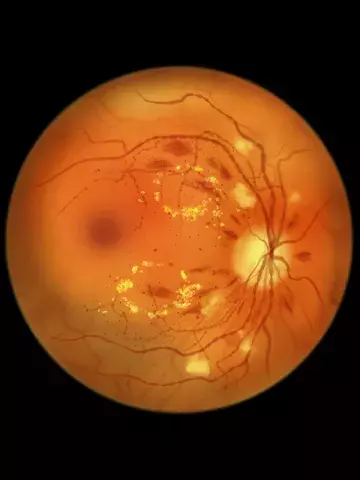Increased retinopathy risk in patients with young-onset diabetes, especially men
By Melanie Hinze
Patients diagnosed with type 2 diabetes before age 40 years have more than double the likelihood of retinopathy, compared with those with later onset diabetes, new research in BMJ Open Diabetes Research & Care suggests.
The study authors collected cross-sectional data from Norwegian general practice electronic medical records for 10,241 adults aged 18 years and over with type 2 diabetes in 2014 and repeated measurements of glycated haemoglobin from 2012 to 2014. They then assessed the associations between young-onset diabetes (YOD) and later-onset type 2 diabetes, sex and retinopathy using multivariate logistic regression.
Among all individuals with type 2 diabetes, 10% were diagnosed before the age of 40 years. These patients with YOD experienced retinopathy at a rate of 25% – twice as frequently as those with later-onset diabetes.
This higher likelihood of retinopathy in YOD was partly explained by higher glycated haemoglobin levels and longer diabetes duration; however, it remained increased in men with YOD, even after accounting for these mediating factors.
The authors suggested this might be an indication of delayed type 2 diabetes diagnosis in men with YOD, and this in turn might account for their excess likelihood of retinopathy.
Professor Lyndell Lim, Head of Clinical Trials Research at the Centre for Eye Research Australia, University of Melbourne and Head of the Ocular Immunology Clinic at the Royal Victorian Eye and Ear Hospital (RVEEH), Melbourne, said she was seeing a similar trend of a greater prevalence of YOD in the Australian population.
‘These patients have similarly been recognised as being at higher risk of developing cardiovascular and other diabetes associated complications than the “more traditional” mature onset type 2 diabetes patients,’ she said. Professor Lim, who is also Consultant Ophthalmologist at both RVEEH and the Royal Melbourne Hospital said this study, ‘reinforces the need to refer these patients for diabetic retinopathy screening at the time of their diagnosis of young-onset type 2 diabetes, given the significant proportion who do have diabetic retinopathy at diagnosis.’
‘This is in line with the current NHMRC Guidelines for the Management of Diabetic Retinopathy; however, the major challenge is adherence [to having regular eye checks] in this age group,’ she added.
Professor Lim told Medicine Today that work is being done to address the barriers to adherence, including the KeepSight Initiative, which is an Australian program designed to increase regular retinopathy screening through a reminder system (https://www.keepsight.org.au).
‘Perhaps GPs may wish to not only refer their patients for diabetic retinopathy screening, but also recommend initiatives such as this to help with long-term adherence to screening,’ she added.


